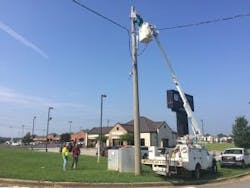Alabama lays groundwork for future automated vehicles
Advanced technology to make traveling safer and more efficient is the focus of a new project led by the University of Alabama and the Alabama Department of Transportation.
Tuscaloosa is the first city in Alabama to install the technology that will collect data for research used to decrease travel time, reduce vehicle crashes and lay the groundwork for future self-driving vehicles.
The project involves installing infrastructure components, known as dedicated short-range communication (DSRC) radios, into 85 traffic signals throughout Tuscaloosa and Northport. The first 50 units are scheduled for implementation this fall. One useful application of this vehicle-to-infrastructure (V2I) connectivity could be red light warnings in vehicles, similar to current collision warnings already installed in newer models.
Only vehicles containing the corresponding DSRC units can communicate with the infrastructure radios. Currently, this equipment does not appear in standard production vehicles, but it is anticipated that the technology will become available over the next decade. Initially, the units will be set up to send information only from infrastructure to vehicles, and not yet from vehicles to infrastructure. DSRC units are unable and not designed to retain or gather any personal information.
The information gathered through the system will allow faculty, staff and students at the university to study signal-phase and timing data, or SPaT messages. These studies will lead to greater interaction between vehicles and traffic signals to communicate information like road conditions or changing signals.
The study is in response to a national challenge by American Association of State Highway and Transportation Officials to install 20 DSRC radios in every state by 2020.
Multiple research centers within the University will be involved in the project, including the Center for Advanced Vehicle Technology, the University Transportation Center for Alabama, the Center for Advanced Public Safety and the Alabama Transportation Institute. The University is working with local, state and federal government agencies, as well as automotive manufactures, on these studies.
---------
News & image source: University of Alabama
